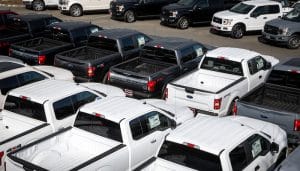With parts of the U.S. starting to reopen from pandemic lockdown, U.S. auto sales continue rebounding faster than many had expected – though the surge in demand could come at a hefty price, automakers offering up record incentives to lure buyers back.
April saw U.S. new car demand fall by nearly half, to levels lower than were seen during the Great Recession. But sales were off just 31% during the week ending May 3, according to data gathered through the J.D. Power PIN network, which tracks real-time transactions at thousands of American dealers.
“We’re in our fifth week of improving market conditions,” said Tyson Jominy, head of the PIN operation at J.D. Power. That was echoed by Thomas King, the research firm’s chief data officer, who added that, “We’re seeing evidence we’re over the worst.”
(Collapsing auto sales, earnings raise talk of bailout – or sales stimulus – program.)
That said, there’s little reason to celebrate, according to Power’s analysis. It is likely to be months before sales reach anything close to where they were expected to be, pre-pandemic, stressed King, adding that full-year numbers could come in as low as 13 million, down from 17.1 million in 2019 – and well off the general consensus among industry analysts going into this year that demand would be down just 2 to 3 percent.

Sales in some parts of the country are down significantly, like New York City has fallen 63 percent.
As has been the case since the first shelter-in-place orders were issued in March, the extent of the downturn varies widely from one market to another. For the week ending on May 3, sales in Dallas were just 1% below pre-pandemic forecasts and, in Tampa, they actually ran about 1% over that forecast.
New York was still down by 63%, with Detroit off 59%, however. But both of those markets – epicenters of the COVID-19 outbreak – still showed marked improvement after sales came to a virtual halt this time last month.
The upturn in demand is actually setting the stage for a different problem in the weeks and months ahead: with dealer inventories declining fast, especially for the full-size pickups that remained unexpectedly strong even during the worst weeks of the coronavirus crisis.
(General Motors bucks the trends and turns small Q1 profit.)
In March, U.S. dealers had an average 136 days’ worth of trucks in stock. That fell to around 68 by the beginning of this week. Because of the wide variety of models, bodies and bed styles, the industry norm is a 103-day stock. So, King cautioned, that could mean some buyers will have to settle for what they find in dealer lots or wait. And that could take a while, as the industry is only beginning to start reopening assembly plants.

Automakers have been offering big incentives to draw people to dealership, but that may prove very costly in the long run.
Automakers took a series of steps to avoid a complete crash in demand, among other things, shifting to online sales where possible, while also boosting incentives. Those pickups have had givebacks averaging more than $7,000 a vehicle since March and, more broadly, last week marked “the first time ever we saw (average) incentives top $5,000 in a week.”
Givebacks may be helping get buyers back to showrooms – real or virtual – but the cost is substantial, contributing to losses that came to around $2 billion each for Fiat Chrysler and for Ford during the first quarter. General Motors delivered a surprise $294 million profit, but it also reported that the coronavirus pandemic generated $1.4 billion in losses.
The impact of the outbreak likely will be felt for an extended period, according to Power. And it will be seen in terms of both new and used cars. With the travel industry all but shut down, and not expected to recover to any significant degree until 2021, rental car companies have slashed to near-zero their own purchases. Off-rental vehicles make up a significant chunk of the nearly new models that flow back to dealers each year, so this means there will be a much lower supply for dealers to sell next year, said Jonathan Banks, a used vehicle analyst with Power.
(After the pandemic: The world of transportation may change dramatically.)
With it yet unclear when the country will truly get back to work – and whether there could be new outbreaks of COVID-19 – it’s going to take time to get a clear picture of what that means for the auto industry. Expect to see “a large amount of uncertainty” in May and beyond, said data chief King.


Blazing the path? Hardly. They are talking about a bail out for the auto industry. How about a “Cash for Clunkers 2”.
The auto industry was a major force in the revival from Great Recession.